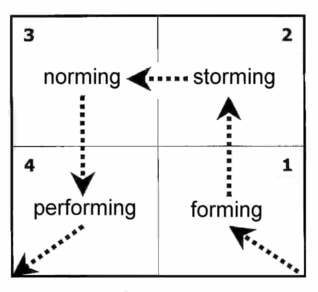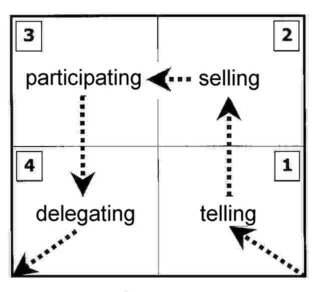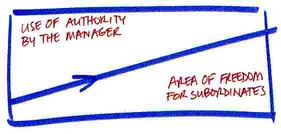Bruce Tuckman's 1965 Team-Development Model
Background Information
Dr Bruce Tuckman published his 'Forming, Storming, Norming, Performing' model in 1965. He later added a fifth stage, Adjourning, in the 1970s.
The 'Forming, Storming, Norming, Performing' theory is an elegant and helpful explanation of team development and behaviour. Similarities can be seen with other models, such as Tannenbaum and Schmidt Continuum and especially with Hersey and Blanchard's Situational Leadership® model, developed about the same time. Both of these theories and how they overlap with Tuckman's model will be briefly outlined below.
Why is Tuckman's Model useful?
Tuckman's model explains that as the team develops maturity and ability, relationships establish, and the leader changes leadership style. Beginning with a directing style, moving through coaching, then participating and finishing with delegation, at which point they are almost detached. At this point, the team may produce a successor leader and the previous leader can move on to develop a new team.
This simple overview of the Tuckman 'Forming, Storming, Norming, Performing' model offers a simple way to understand how groups develop. Tuckman's model is especially helpful in training people on group work, thus enabling groups to fulfil their full potential.
Related Resources and Theories
- This progression of team behaviour and leadership style can be seen clearly in the Tannenbaum and Schmidt Continuum - the authority and freedom extended by the leader to the team increases while the control of the leader reduces. In Tuckman's 'Forming, Storming, Norming, Performing' model, Hersey's and Blanchard's Situational Leadership® model and in Tannenbaum and Schmidt's Continuum, we see the same effect, represented in three ways.
- See also Leadership tips and Leadership theories, both of which relate strongly to understanding and managing groups.
- The Conscious Competence Learning Model, together with Kolb's Learning Cycle Theory, and the Johari Window Model all provide helpful additional ways to learn and to teach others about Tuckman's ideas and their applications.
What are the Four Stages of Team Development?
The progression is:
- Forming
- Storming
- Norming
- Performing
Below the features of each phase will be outlined in detail.
Stage 1: Forming
This stage is classified by:
- High dependence on the leader for guidance and direction.
- Little agreement on team objectives other than those received from the leader.
- Individual roles and responsibilities are unclear.
- The leader must be prepared to answer lots of questions about the team's purpose, objectives and external relationships. Processes are often ignored.
- Members test the tolerance of the system and leader.
- The leader directs (similar to Situational Leadership® 'Telling' mode).
Stage 2: Storming
This stage is classified by:
- A lack of agreement when it comes to making group decisions. Team members attempt to establish themselves and their position in relation to other team members and the leader, who might receive challenges from team members.
- Clarity of the team's purpose increases but many uncertainties persist.
- Cliques and factions form. This may lead to power struggles. The team needs to focus on its goals to avoid becoming distracted by relationships and emotional issues.
- Compromises may be required to enable progress.
- The leader coaches (similar to Situational Leadership® 'Selling' mode).
Stage 3: Norming
This stage is classified by:
- Agreement and consensus largely forms among the team, who respond well to facilitation by the leader.
- Roles and responsibilities are clear and accepted.
- Big decisions are made by group agreement. Smaller decisions may be delegated to individuals or small teams within the group.
- Commitment and unity are strong. The team may engage in fun and social activities.
- The team discusses and develops its processes and working style.
- There is general respect for the leader and leadership responsibilities are now shared amongst the team.
- The leader facilitates and enables (similar to the Situational Leadership® 'Participating' mode).
Stage 4: Performing
This stage is classified by:
- The team's increased strategic awareness. It is now clear why the team is doing what it is doing.
- The shared vision of the team. It is now independent and does not need interference or participation from the leader.
- A focus on over-achieving goals and the team makes most of the decisions against criteria agreed with the leader. The team has a high degree of autonomy.
- Disagreements. However, they are now resolved within the team positively, and necessary changes to processes and structure are made by the team.
- The team can work towards achieving the goal and attend to relationship, style and process issues along the way.
- Team members look after each other.
- The team requires delegated tasks and projects from the leader.
- The team does not needing to be instructed or assisted. Team members might ask for assistance from the leader with personal and interpersonal development.
- The leader delegating and overseeing (similar to the Situational Leadership® 'Delegating' mode).
Tuckman's Model of Team Development Diagram
This is a diagram of Tuckman's four stages of team development. Below is an outline of the fifth stage, which Tuckman only added later after refining his theory.

Better quality diagrams are available as separate files here:
Stage 5: Adjourning
Bruce Tuckman refined his theory in 1975 and added a fifth stage to the 'Forming, Storming, Norming, Performing' model: Adjourning. This is also referred to as Deforming and Mourning.
Adjourning is arguably more of an adjunct to the original four-stage model rather than an extension - it views the group from a perspective beyond the purpose of the first four stages.
The Adjourning phase is certainly very relevant to the people in the group and their well-being, but not to the main task of managing and developing a team, which is more central to the original four stages.
Tuckman's fifth stage, Adjourning, is the break-up of the group, once the task is completed successfully and its purpose fulfilled.
- From an organisational perspective, recognition of and sensitivity to people's vulnerabilities in Tuckman's fifth stage is helpful. This is specifically if members of the group have been closely bonded and feel a sense of insecurity or threat from this change.
- Feelings of insecurity would be natural for people with high 'steadiness' attributes (as regards the 'four temperaments' or DISC model) and with strong routine and empathy style (as regards the Benziger thinking styles model, right and left basal brain dominance).
Hersey and Blanchard's Situational Leadership® 
The classic Situational Leadership® model of management and leadership style also illustrates the ideal development of a team from immaturity (stage 1) through to maturity (stage 4).
According to this model, the leadership style progressively develops from relatively detached task-directing (1), through the more managerially-involved stages of explanation (2) and participation (3), to the final stage of relatively detached delegation (4), at which time ideally the team is largely self-managing, and contains at least one potential management/leadership successor.
The aim of the leader or manager is, therefore, to develop the team through the four stages, and then to progress on to another role.
The model also illustrates four main leadership and management styles, which a good leader can switch between, depending on the situation (i.e., the team's maturity relating to a particular task, project or challenge).
Background and Resources
- Situational Leadership® is a trademark of the Center for Leadership Studies, which represents the interests and products of Dr Paul Hersey. Ken Blanchard (who incidentally wrote 'The One Minute Manager') went on to develop the Situational Leadership® system into what he called Situational Leadership II®, and which now covers a range of products marketed by his organization, The Ken Blanchard Companies.
- Use of material relating to Situational Leadership® and/or Situational Leadership II® requires licence and agreement from the respective companies.
- For more detail on Leadership theories.
Tannenbaum and Schmidt Continuum
The Tannenbaum and Schmidt Continuum also correlates or overlaps with the models above in the sense that management style tends to offer more freedom as the group matures.
The diagonal line loosely equates to the dotted line on the other two models. As the team matures and becomes more self-sufficient and self-directing, so the manager's style should react accordingly, ideally becoming more detached, more delegating, encouraging and enabling the group to run itself, and for a successor to emerge.

See the Tannenbaum and Schmidt page for more detailed notes about this model.
Other Resources Relevant to Team Development
- Find out more about Leadership theories.
- See the Johari Window model, which can assist the process of mutual awareness development that is a major aspect within Tuckman's model, and in the development of effective groups.
- For an additional and useful perspective on human development - especially concerning group members of different ages see Erik Erikson's Psychosocial Theory.
- The Personality Models and Theories section explores the behaviour and style of individuals and the implications this has on managing groups, as does the Learning styles and multiple intelligences section.
See also
Authorship/Referencing
Situational Leadership® is a trademark of the Centre for Leadership Studies. Situational Leadership II® is a trademark of The Ken Blanchard Companies. Use of material relating to Situational Leadership® and/or Situational Leadership II® requires licence and agreement from the respective companies.
© Bruce Tuckman 1965 original 'Forming-storming-norming-performing' concept; Alan Chapman 2001-2013 review and code.
Thanks to S Doran for the suggestion. And thanks also C Lloyd for pointing out the error in these diagrams, duly corrected Aug 2008 - storming and norming were inverted.